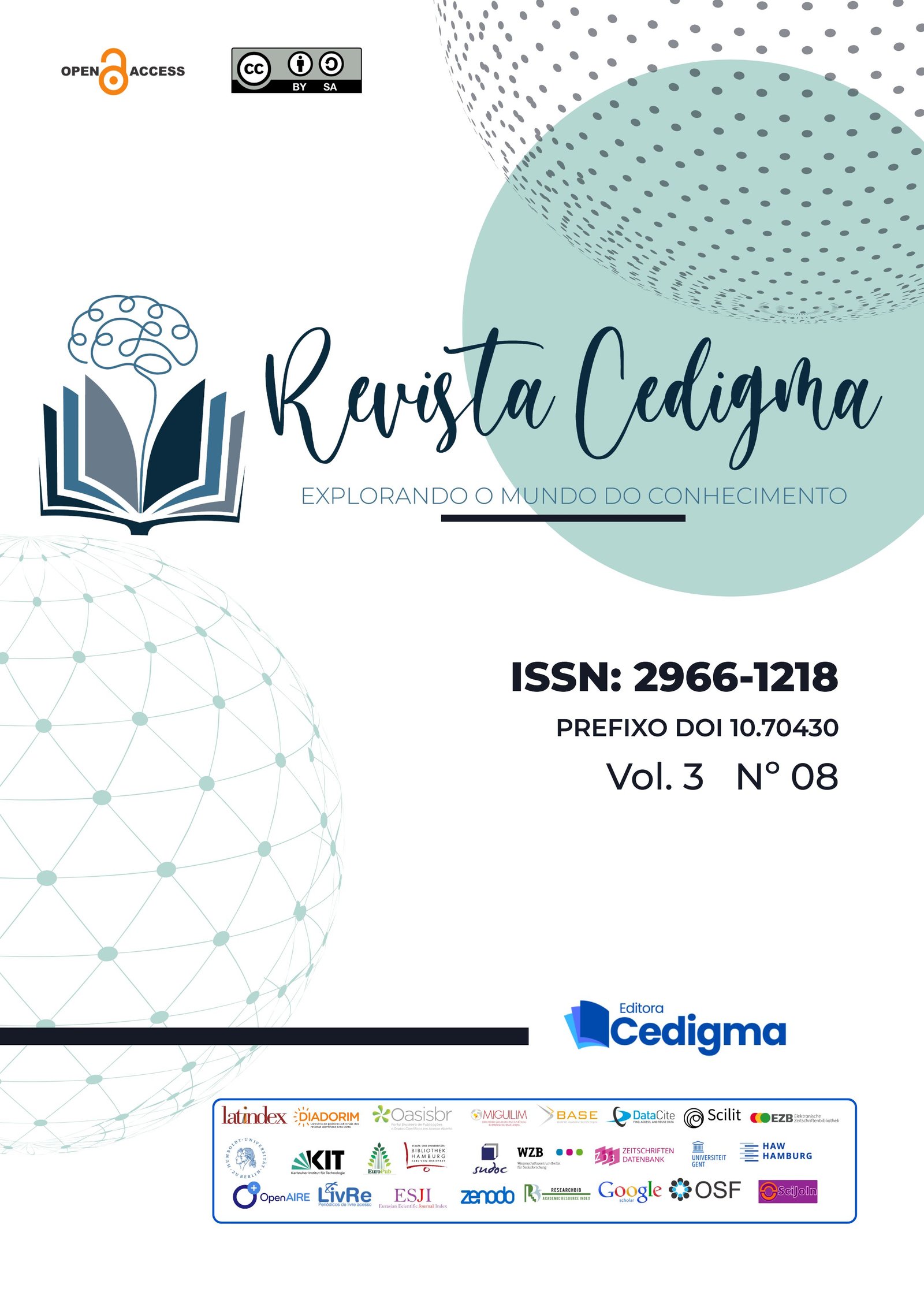Temporomandibular; Dysfunction; Pain; Syndrome.
DOI:
https://doi.org/10.5281/zenodo.17605407Keywords:
Temporomandibular; Dysfunction; Pain; Syndrome.Abstract
Temporomandibular Dysfunction Syndrome (TMDS) is a complex condition affecting the temporomandibular joint, causing pain and functional impairment. Factors such as high stress, parafunctional habits, and inadequate postures can exacerbate the prevalence of TMDS. Understanding the frequency and factors associated with this syndrome in this group is fundamental to developing appropriate prevention and treatment strategies. This study aims to analyze the prevalence of Temporomandibular Dysfunction Syndrome among university students, identifying the most affected groups and the main risk factors associated with the condition. The analysis revealed that TMDS is more prevalent among female students and those in more advanced academic years. Factors such as high stress, bruxism, and inadequate postures were identified as significant contributors to the development of the syndrome. Furthermore, the diversity of courses and socioeconomic backgrounds of the students also showed variability in the prevalence of TMDS. Therefore, the need for targeted interventions for the prevention and management of TMD among university students is highlighted; stress management, posture correction, and control of parafunctional habits are recommended. It is expected that future studies should include a more diverse sample and follow students longitudinally to better understand the evolution of TMD and develop more effective prevention and treatment strategies, thus promoting a healthier and more productive academic environment.
Downloads
References
BEZERRA, Berta Priscilla Nogueira et al. Prevalência da disfunção temporomandibular e de diferentes níveis de ansiedade em estudantes universitários. Revista Dor, v. 13, p. 235-242, 2012. Disponível em: https://www.scielo.br/j/rdor/a/QtcdYFrvkxwWdBPq8BNSGnk/?format=html&lang=pt, Acesso em: 19 de abril, 2024.
BOTELHO, Louise Lira Roedel; DE ALMEIDA CUNHA, Cristiano Castro; MACEDO, Marcelo. O método da revisão integrativa nos estudos organizacionais. Gestão e sociedade, v. 5, n. 11, p. 121-136, 2011. Disponível em: 1220-Texto_do_artigo-641-4530-10-20111202.pdf_filename_UTF-81220-Texto_do_artigo-641-4530-10-20111202-libre.pdf (d1wqtxts1xzle7.cloudfront.net) , Acessado em 21 de abril, 2024.
DANTAS, H. L. de L. .; COSTA, C. R. B. .; COSTA, L. de M. C. .; LÚCIO, I. M. L. .; COMASSETTO, I. . Como elaborar uma revisão integrativa: sistematização do método científico. Revista Recien - Revista Científica de Enfermagem, [S. l.], v. 12, n. 37, p. 334–345, 2022. DOI: 10.24276/rrecien2022.12.37.334-345. Disponível em: https://recien.com.br/index.php/Recien/article/view/575 . Acesso em: 5 maio. 2024.
DE SOUSA, Luís Manuel Mota et al. A metodologia de revisão integrativa da literatura em enfermagem. Revista investigação em enfermagem, v. 21, n. 2, p. 17-26, 2017. Disponível em: RIE21.pdf (sinaisvitais.pt) , Acessado em 21 de abril, 2024.
LOIOLA, Matheus Mendes Carneiro; MONTE, Francisca Mariane Martins; NOGUEIRA, Luís Henrique dos Santos. A prevalência de sinais e sintomas de disfunção temporomandibular em acadêmicos de um centro universitário: associação de quadros emocionais. BrJP, v. 6, p. 404-409, 2023. Disponível em: https://www.scielo.br/j/brjp/a/mCXwMhnZ3GQQ3Ry3zJk56TP/?lang=pt , Acessado em 20 de abril, 2024.
MAIA, Caio Rodrigues et al. Prevalência da disfunção temporomandibular associada aos fatores psicológicos em universitários Prevalence of temporomandibular joint disorder associated to psychological factors in college students. Brazilian Journal of Development, v. 8, n. 7, p. 50375-50387, 2022.
MASSENA, Patricia; FRASSETTO, Silvana Soriano. Aspectos psicológicos associados à disfunção temporomandibular: uma revisão sistemática da literatura. Aletheia, n. 47-48, 2015.
MEDEIROS, Suéllen Peixoto de; BATISTA, André Ulisses Dantas; FORTE, Franklin Delano Soares. Prevalência de sintomas de disfunção temporomandibular e hábitos parafuncionais em estudantes universitários. RGO. Revista Gaúcha de Odontologia (Online), v. 59, n. 2, p. 201-208, 2011. Disponível em: http://revodonto.bvsalud.org/scielo.php?pid=S1981-86372011000200005&script=sci_arttext , Acesso em: 19 de abril, 2024.
PINTO, Raydelane Grailea Silva et al. Associação entre sinais e sintomas de disfunção temporomandibular com depressão em universitários: estudo descritivo. Revista dor, v. 18, p. 217-224, 2017.
PRATES, A. M. de S.; SANTOS, E. S.; BARROS, F. P. C. S.; MORAIS, K. N. F.; LIMA, R. S.; LIMA, V. N. de; MEORIN NOGUEIRA, L. Existe relação entre a prevalência de disfunção temporomandibular e a fase do curso durante a graduação?. ARCHIVES OF HEALTH INVESTIGATION, [S. l.], v. 10, n. 6, p. 941–948, 2021. DOI: 10.21270/archi.v10i6.5021. Disponível em: https://archhealthinvestigation.emnuvens.com.br/ArcHI/article/view/5021 . Acesso em: 21 abr. 2024.
SOARES, Cassia Baldini et al. Revisão integrativa: conceitos e métodos utilizados na enfermagem. Revista da Escola de Enfermagem da USP, v. 48, p. 335-345, 2014. Disponível em: https://www.scielo.br/j/reeusp/a/3ZZqKB9pVhmMtCnsvVW5Zhc/?lang=pt , Acessado em 22 de abril, 2024.
SOARES, Lélio Fernando Ferreira et al. Correlação entre o evento da pandemia de COVID-19 e sintomas de ansiedade, depressão e de disfunção temporomandibular em estudantes universitários: estudo transversal. BrJP, v. 6, p. 269-276, 2023.
SOUZA, Marcela Tavares de; SILVA, Michelly Dias da; CARVALHO, Rachel de. Revisão integrativa: o que é e como fazer. Einstein (São Paulo), v. 8, p. 102-106, 2010. Disponível em: SciELO - Brasil - Integrative review: what is it? How to do it? Integrative review: what is it? How to do it? , Acessado em 21 de abril, 2024.
TAKEMOTO, Marcos Massaro; DO AMARAL JÚNIOR, Orlando Luiz; BONOTTO, Danielle Medeiros Veiga. Prevalência da Disfunção Temporomandibular (DTM) associada à níveis de ansiedade em acadêmicos de Odontologia. Revista da Faculdade de Odontologia-UPF, v. 29, n. 1, 2024.
Downloads
Published
Issue
Section
License
Copyright (c) 2025 Camilla de Freitas Góis, Maria Clara Almeida dos Santos Silva, Sidiane Sirley Nunes Silva Boneth (Autor)

This work is licensed under a Creative Commons Attribution-ShareAlike 4.0 International License.
- Atribuição — Você deve dar o crédito apropriado , fornecer um link para a licença e indicar se mudanças foram feitas . Você pode fazer isso de qualquer maneira razoável, mas não de nenhuma forma que sugira que o licenciante endossa você ou seu uso.
- Compartilhamento pela mesma licença — Se você remixar, transformar ou criar a partir do material, deverá distribuir suas contribuições sob a mesma licença do original.
- Sem restrições adicionais — Você não pode aplicar termos legais ou medidas tecnológicas que restrinjam legalmente outros de fazer qualquer coisa que a licença permita.

















